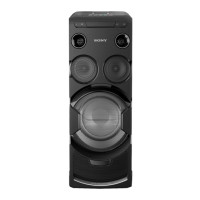
Do you have a question about the Sony MHC-V77DW and is the answer not in the manual?
| Optical Disc Player Type | CD Player |
|---|---|
| Number of Optical Discs | 1 |
| Cassette Deck | No |
| Audio Formats Supported | MP3, WMA, AAC |
| Radio Type | FM |
| Ethernet LAN | No |
| CD Player | Yes |
| Wireless Connectivity | Bluetooth, NFC |
| Inputs | USB, Microphone |
| Features | Gesture Control, DJ Effects, Karaoke |
Connect the system components and cables for initial setup and operation.
Turn off the system's demo mode, usually by pressing a display button repeatedly.
Guide for correctly inserting batteries into the remote control unit.
Instructions for linking the audio system to a TV via HDMI or video cables.
Safety guidelines and methods for moving the system unit safely.
Adjusting video output color system (PAL/NTSC) to match your television.
Basic initial adjustments for system setup and readiness for playback.
Options to switch between different display modes, like demonstration or power saving.
Important information and compatibility checks for USB devices before connection.
Step-by-step instructions for playing audio/video from discs and USB devices.
Controls for stopping, pausing, resuming, and selecting specific tracks or files.
Methods to locate tracks, chapters, scenes, or files by number or time code.
How to select playback modes like Normal Play, Shuffle Play, and Repeat Play.
Setting age-based playback restrictions for DVD videos using a password.
Displaying playback details like time, title, artist, and file type on the TV screen.
Accessing and modifying system settings for language, video, audio, and HDMI.
Guidelines for selecting and preparing USB devices for music transfer.
Process for copying music files from discs to a USB device, including bit rate selection.
Instructions on how to delete unwanted audio files or entire folders from USB storage.
Steps for tuning into FM radio stations, including automatic and manual tuning.
Saving favorite radio stations using preset numbers for easy tuning.
An overview of BLUETOOTH technology, versions, profiles, and codecs supported.
Step-by-step guide to wirelessly connect and register BLUETOOTH devices with the system.
How to play audio content from a paired BLUETOOTH device through the system.
Using NFC technology for quick, tap-based pairing and connection with compatible smartphones.
Selecting appropriate audio codecs like AAC, LDAC, or SBC for optimal sound quality.
Choosing between Wi-Fi or wired LAN connection for network access.
Configuring network settings by directly connecting the system to a computer via LAN cable.
Instructions for streaming music from online services like Google Cast and Spotify.
Introduction to using hand gestures to control playback, DJ, sampler, and karaoke modes.
Specific hand swipe actions for controlling playback and DJ effects.
Using gestures to adjust microphone volume, pitch, and add effects during karaoke.
Modifying bass, sound effects (Fiesta, Arena), and preset sound profiles.
Activating a mode to enhance the atmosphere of live sports broadcasts.
Customizing equalizer levels and saving them as a personal sound profile.
Using the SongPal app for remote system control, browsing content, and adjusting settings.
Utilizing the Fiestable app for interactive party features like DJ effects and karaoke control.
Managing integrated system and TV control via HDMI, including power sync and audio return.
Configuring system power off, audio control, standby modes, and remote control features.
Connecting multiple audio systems to play music in unison for parties.
Comprehensive guide to karaoke features including microphone setup, vocal effects, and scoring.
Setting the automatic turn-off timer and connecting external audio devices.
Enabling Child Lock and Party Lock to temporarily disable the unit's touch panel.
Managing automatic standby, BLUETOOTH/Network standby modes, and Wi-Fi signal status.
Procedures for updating system software automatically or manually via internet or USB.
A guide to diagnosing and resolving common problems encountered with the system.
Steps to reset system settings, excluding parental controls, to their original factory state.
Explanations and corrective actions for various error messages and codes displayed by the system.
Important safety warnings, handling instructions, and operational precautions for the unit.